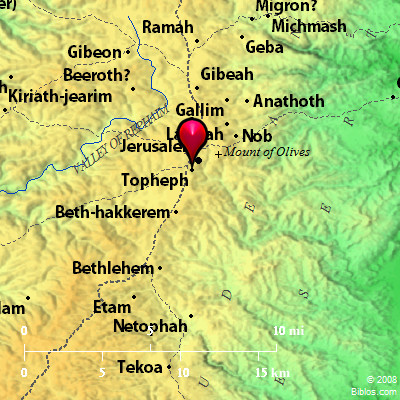Atlas  Valley of Hinnom and surrounding area Maps Created using Biblemapper 3.0 Additional data from OpenBible.info You are free to use up to 50 Biblos coprighted maps (small or large) for your website or presentation. Please credit Biblos.com. Occurrences Joshua 15:8 The border went up by the valley of the son of Hinnom to the side of the Jebusite southward (the same is Jerusalem); and the border went up to the top of the mountain that lies before the valley of Hinnom westward, which is at the farthest part of the valley of Rephaim northward.Joshua 15:8 The border went up by the valley of the son of Hinnom to the side of the Jebusite southward (the same is Jerusalem); and the border went up to the top of the mountain that lies before the valley of Hinnom westward, which is at the farthest part of the valley of Rephaim northward. Joshua 18:16 The border went down to the farthest part of the mountain that lies before the valley of the son of Hinnom, which is in the valley of Rephaim northward. It went down to the valley of Hinnom, to the side of the Jebusite southward, and went down to En Rogel. Joshua 18:16 The border went down to the farthest part of the mountain that lies before the valley of the son of Hinnom, which is in the valley of Rephaim northward. It went down to the valley of Hinnom, to the side of the Jebusite southward, and went down to En Rogel. 2 Kings 23:10 He defiled Topheth, which is in the valley of the children of Hinnom, that no man might make his son or his daughter to pass through the fire to Molech. 2 Chronicles 28:3 Moreover he burnt incense in the valley of the son of Hinnom, and burnt his children in the fire, according to the abominations of the nations whom Yahweh cast out before the children of Israel. 2 Chronicles 33:6 He also made his children to pass through the fire in the valley of the son of Hinnom; and he practiced sorcery, and used enchantments, and practiced sorcery, and dealt with those who had familiar spirits, and with wizards: he worked much evil in the sight of Yahweh, to provoke him to anger. Nehemiah 11:30 Zanoah, Adullam, and their villages, Lachish and its fields, Azekah and its towns. So they encamped from Beersheba to the valley of Hinnom. Jeremiah 7:31 They have built the high places of Topheth, which is in the valley of the son of Hinnom, to burn their sons and their daughters in the fire; which I didn't command, nor did it come into my mind. Jeremiah 7:32 Therefore, behold, the days come, says Yahweh, that it shall no more be called Topheth, nor The valley of the son of Hinnom, but The valley of Slaughter: for they shall bury in Topheth, until there be no place to bury. Jeremiah 19:2 and go forth to the valley of the son of Hinnom, which is by the entry of the gate Harsith, and proclaim there the words that I shall tell you; Jeremiah 19:6 therefore, behold, the days come, says Yahweh, that this place shall no more be called Topheth, nor The valley of the son of Hinnom, but The valley of Slaughter. Jeremiah 32:35 They built the high places of Baal, which are in the valley of the son of Hinnom, to cause their sons and their daughters to pass through the fire to Molech; which I didn't command them, neither did it come into my mind, that they should do this abomination, to cause Judah to sin. Encyclopedia HINNOM, VALLEY OFhin'-om (ge hinnom, Joshua 15:8; Joshua 18:16; "valley of the son of Hinnom" (ge bhen hinnom), Joshua 15:8; Joshua 18:16 2 Chronicles 28:3; 2 Chronicles 33:6; Jeremiah 7:31; 19:2, 6; 32:35:00; "valley of the children (sons) of Hinnom" (ge bhene hinnom), 2 Kings 23:10; or simply "the valley," literally, the "hollow" or "ravine" (ha-gay'), 2 Chronicles 26:9 Nehemiah 2:13, 15; Nehemiah 3:13 Jeremiah 31:40 and, perhaps also, Jeremiah 2:23 (the above references are in the Hebrew text; there are some variations in the Septuagint)): The meaning of "Hinnom" is unknown; the expressions ben Hinnom and bene Hinnom would suggest that it is a proper name; in Jeremiah 7:32; Jeremiah 19:6 it is altered by the prophet to "valley of slaughter," and therefore some have thought the original name must have had a pleasing meaning. |



